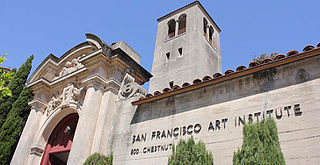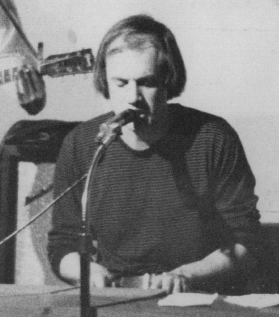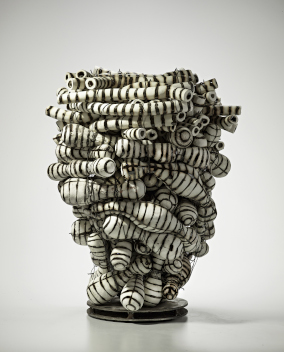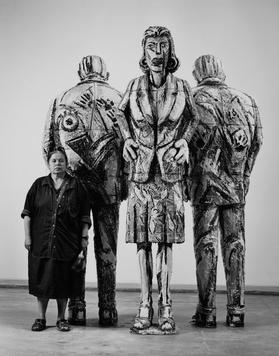Related Research Articles

San Francisco Art Institute (SFAI) was a private college of contemporary art in San Francisco, California. Founded in 1871, SFAI was one of the oldest art schools in the United States and the oldest west of the Mississippi River. Approximately 220 undergraduates and 112 graduate students were enrolled in 2021. The institution was accredited by the Western Association of Schools and Colleges (WASC) and the National Association of Schools of Art and Design (NASAD), and was a member of the Association of Independent Colleges of Art and Design (AICAD). The school closed permanently in July 2022.

The Kansas City Art Institute (KCAI) is a private art school in Kansas City, Missouri. The college was founded in 1885 and is an accredited by the National Association of Schools of Art and Design and Higher Learning Commission. The institute has approximately 75 faculty members and 700 students, and offers a Bachelor of Fine Arts degree.

Peter Voulkos was an American artist of Greek descent. He is known for his abstract expressionist ceramic sculptures, which crossed the traditional divide between ceramic crafts and fine art. He established the ceramics department at the Los Angeles County Art Institute and at UC Berkeley.
Toshiko Takaezu was an American ceramic artist, painter, sculptor, and educator whose oeuvre spanned a wide range of mediums, including ceramics, weavings, bronzes, and paintings. She is noted for her pioneering work in ceramics and has played an important role in the international revival of interest in the ceramic arts. Takaezu was known for her rounded, closed ceramic forms which broke from traditions of clay as a medium for functional objects. Instead she explored clay's potential for aesthetic expression, taking on Abstract Expressionist concepts in a manner that places her work in the realm of postwar abstractionism. She is of Japanese descent and from Pepeeko, Hawaii.

Manuel John Neri Jr. was an American sculptor who is recognized for his life-size figurative sculptures in plaster, bronze, and marble. In Neri's work with the figure, he conveys an emotional inner state that is revealed through body language and gesture. Since 1965 his studio was in Benicia, California; in 1981 he purchased a studio in Carrara, Italy, for working in marble. Over four decades, beginning in the early 1970s, Neri worked primarily with the same model, Mary Julia Klimenko, creating drawings and sculptures that merge contemporary concerns with Modernist sculptural forms.

Ruth Duckworth was a modernist sculptor who specialized in ceramics, she worked in stoneware, porcelain, and bronze. Her sculptures are mostly untitled. She is best known for Clouds over Lake Michigan, a wall sculpture.

Robert Brady is an American modernist sculptor who works in ceramics and wood. Born in Reno, Nevada, he has made his home in the San Francisco Bay Area for many decades. Brady is a multi-faceted artist who works in ceramics, wood, painting, and illustration, and is best known for his abstract figurative sculptures. Brady came out of the California Clay movement, and the Bay Area Arts scene of the 1950s and 1960s, which includes artists such as Peter Voulkos, Viola Frey, Stephen de Staebler, and Robert Arneson who was his mentor and teacher in college.

Funk art is an American art movement that was a reaction against the nonobjectivity of abstract expressionism. An anti-establishment movement, Funk art brought figuration back as subject matter in painting again rather than limiting itself to the non-figurative, abstract forms that abstract expressionists such as Jackson Pollock and Mark Rothko were depicting. The movement's name was derived from the jazz musical term "funky", describing the passionate, sensuous, and quirky. During the 1920s, jazz was thought of as very basic, unsophisticated music, and many people believed Funk was an unrefined style of art as well. The term funk also had negative connotations because the word had an association with a foul odor. Throughout the 1960s and 1970s, Funk was a popular art form, mainly in California's Bay Area in the United States. Although discussed as a cohesive movement, Funk artists did not feel as if they belonged to a collective art style or group. This is because while its artists shared the same attitudes and created similar works, they were not necessarily working together.

Ron Nagle is an American sculptor, musician and songwriter. He is known for small-scale, refined sculptures of great detail and compelling color.

Annabeth Rosen is an American sculptor best known for abstract ceramic works, as well as drawings. She is considered part of a second generation of Bay Area ceramic artists after the California Clay Movement, who have challenged ceramic traditions involving expression, form and function and helped spur the medium's acceptance in mainstream contemporary sculpture. Rosen's sculptures range from monumental to tabletop-sized, and emerge out of an accumulative bricolage process combining dozens or hundreds of fabricated parts and clay fragments and discards. Reviewers characterize her art as deliberately raw, both muscular and unapologetic feminine, and highly abstract yet widely referential in its suggestions of humanoid, botanical, aquatic, artificial, even science-fictional qualities. Critic Kay Whitney wrote that her work is "visceral in its impact, violent even, but also sensual and evocative" and "floats between the poles of the comic and the mordant."
Mary Tuthill Lindheim, born Mary Barbara Tuthill, and also known professionally as Mary Tuthill or Mary Lindheim, was an American sculptor and studio potter.

Viola Frey was an American artist working in sculpture, painting and drawing, and professor emerita at California College of the Arts. She lived and worked in the San Francisco Bay Area and was renowned for her larger-than-life, colorfully glazed clay sculptures of men and women, which expanded the traditional boundaries of ceramic sculpture.

Cheryl Tall is an American visual artist whose work is primarily in the medium of sculpture and large wall installations in addition to, mixed-media, oil and acrylic painting. Tall is most notable for her intricate sculptures and her works have been in prominent and private collections all over the world. She has an MFA from the University of Miami and her present art studio is in Leucadia, CA.
Alicia McCarthy is an American painter. She is a member of San Francisco's Mission School art movement. Her work is considered to have Naïve or Folk character, and often uses unconventional media like housepaint, graphite, or other found materials. She is currently based in Oakland, California.

Susannah Israel is an American contemporary artist, writer and composer living in east Oakland, California. She moved to the Bay Area as a young parent in 1976. Her recognizable figures are highly expressive, and serve as visual extensions of her critical and allegorical narratives. Israel has published writing from 2000–present and musical compositions since 2013.
Michelle Gregor is a San Francisco-based figurative sculptor. She works in mid-fire stoneware ceramic and porcelain.

Nancy Selvin is an American sculptor, recognized for ceramic works and tableaux that explore the vessel form and balance an interplay of materials, minimal forms, and expressive processes. She emerged in the late 1960s among a "second generation" of Bay Area ceramic artists who followed the California Clay Movement and continued to challenge ceramic traditions involving expression, form and function, and an art-world that placed the medium outside its established hierarchy. Her work has been exhibited at the Los Angeles County Museum of Art (LACMA), Denver Art Museum, Daum Museum of Contemporary Art and Kohler Arts Center, and belongs to the public art collections of LACMA, the Smithsonian Institution, Oakland Museum of California, and Crocker Art Museum, among others. Critic David Roth has written, "Selvin's position in the top rank of ceramic artists has come through a process of rigorous self-examination … what differentiates [her] is that she eschews realism and functionality, indicating a level of intellectual engagement not always found among ceramicists." Writer and curator Jo Lauria described Selvin's tableaux as "elegiac and stylistically unified" works that serve as "forceful essays on the relationship between realism and abstraction, object and subject, decoration and use." Selvin lives and works in the Berkeley, California area.
Lisa Reinertson is an American sculptor who works in ceramics and bronze.
Brie Ruais is an American artist based in Brooklyn, New York, working in large “multi-faceted” ceramic sculptures, performance, photography, video, and site-specific installation.
Wanxin Zhang is a Chinese-American sculptor based in San Francisco, known for his large-scale ceramic figures, formless ceramic structures, and bronze pieces. He is recognized as one of the leading artists in the new generation of the Bay Area clay movement. Zhang's work is characterized by a fusion of California Funk influence and references to Chinese history. His monumental clay figures convey themes of globalization, politics, and power by reshaping traditional symbols with contemporary pop culture elements. Zhang's work is in the Smithsonian American Art Museum Collections.
References
- 1 2 3 4 5 6 Berzon, Stephanie (2014). "Hands on Materials: An Interview with Ruby Neri". ArtSlant.
- 1 2 "Salon 94 | Ruby Neri". Salon 94. Retrieved 2024-01-24.
- ↑ "Reminisce Remembered" by Amor Sans Blague, Motility Blog, April 30, 2005.
- ↑ "Salon 94 | Ruby Neri". Salon 94. Retrieved 2024-01-24.
- ↑ Dame, The Dinghy (2013). "Meet Susan Neri of South Forty". Floating Homes. 06: 3–4.
- ↑ "Salon 94 | Ruby Neri". Salon 94. Retrieved 2024-01-24.
- 1 2 3 4 5 6 7 8 9 10 11 Boas, Natasha (2014). Energy That is All Around. San Francisco: San Francisco Art Institute and Grey Art Gallery.
- ↑ "Salon 94 | Ruby Neri". Salon 94. Retrieved 2024-01-24.
- 1 2 3 4 Holloway, Evan (2014). "Artist Portfolio - Ruby Neri". Los Angeles Review of Books: 56–71.
- 1 2 Lilley, Claire (2017). Vitamin C: Clay and Ceramic in Contemporary Art. New York City: Phaidon.
- 1 2 3 4 "Ruby Neri - Why I Create". Phaidon. 2017. Retrieved November 26, 2017.